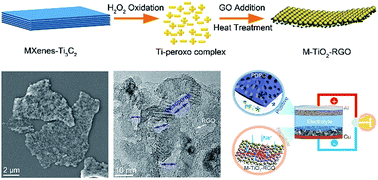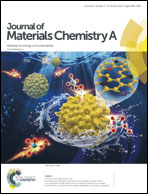Graphene-coupled Ti3C2 MXenes-derived TiO2 mesostructure: promising sodium-ion capacitor anode with fast ion storage and long-term cycling†
Abstract
Sodium-ion-based capacitors and batteries are considered as a low-cost energy storage technology alternative to their lithium-ion counterparts owing to the abundance of sodium in Earth. Their widespread use is however limited by the lack of high-performance electrode materials. In this work, we report that MXenes-Ti3C2 can be oxidized into a Ti-peroxo complex gel at room temperature by simply adding H2O2, from concentrated to dilute. The highly water-soluble property of this gel allows the synthesis of a graphene-supported TiO2 nanocomposite with highly porous nano-/meso-hybrid architecture via a more facile and environmentally friendly way. The unique hybrid architecture of the produced TiO2–RGO nanocomposite results in pseudocapacitive behavior in Na+ charge storage with high reversibility, fast kinetics, long cyclability, and negligible degradation to the parent structure. By incorporating the TiO2–RGO composite as the anode, a novel sodium-ion capacitor is constructed that is capable of operating at a high voltage of 4.0 V and delivering a maximum energy density of 94.7 W h kg−1, which is comparable to lithium-ion based capacitors. The approach reported here could be potentially extended for fabricating a host of MXenes-derived metal oxide nanomaterials or nanocomposites for numerous applications, particularly in view of the expanding MXenes portfolio.



 Please wait while we load your content...
Please wait while we load your content...